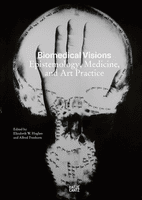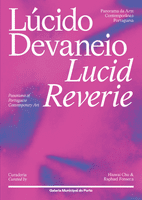| | BOOK FORMAT
Clth, 9 x 9.5 in. / 208 pgs / 160 color. PUBLISHING STATUS
Pub Date 7/31/2012
Out of print DISTRIBUTION
D.A.P. Exclusive
Catalog: SPRING 2012 p. 52 PRODUCT DETAILS
ISBN 9780878467693 TRADE
List Price: $45.00 CAD $60.00 GBP £40.00 AVAILABILITY
Not available | TERRITORY
WORLD | | THE FALL 2025 ARTBOOK | D.A.P. CATALOG  | | Preview our FALL 2025 catalog, featuring more than 500 new books on art, photography, design, architecture, film, music and visual culture.
|
| | | The Brittle Decade: Visualizing Japan in the 1930sText by John W. Dower, Anne Nishimura Morse, Jacqueline M. Atkins, Frederic A. Sharf.
 Visualizing modernism in prewar JapanModernity took many forms in 1930s Japan, but in the tumultuous years before militarism pushed the country toward global aggression, it was most visibly associated with a glittering consumer culture. Inundated with western jazz-age trends and new technologies, Japan’s big cities, especially Tokyo, offered the most enticing attractions to a newly liberated generation: bustling streets of department stores, cafés and teahouses, movie theaters and ballroom dance halls. Modern architecture, industrial design and fashion overshadowed traditional arts as Japan strove to take its place in a cosmopolitan world. The Brittle Years examines the different ways in which designers and artists visualized what it meant to be modern in Japan in the years leading up to World War II. Its 160 full-color illustrations of paintings, textiles and graphic arts are astonishing not only for their great visual impact but also for the insight they provide into a rapidly transforming nation. Among the more surprising images are kimonos bearing patterns of tanks or futuristic cityscapes, paintings of fashionable Japanese women with bobbed hair in western dress and handbills of factory and agricultural workers joined in solidarity. Essays by leading experts on Japanese art and history, including the Pulitzer Prize-winning author John W. Dower, elucidate the many tensions within Japanese society and show how and why such images of power, progress, and beauty helped the nation celebrate and divert modernity to new purposes during these brittle years.
Featured image, Tateishi Harumi's 1934 painting, "Clover," is reproduced from The Brittle Decade: Visualizing Japan in the 1930s.PRAISE AND REVIEWSBookforum Jessica Loudis In the twenty-two years between the day the 1923 Kanto earthquake razed Tokyo and the months in which American bombers demolished it anew, modernity arrived in Japan. Ushered in by the creeping popularity of Western fashions, the rise of mass communication and transit, and the Europeanizing of urban public life, the "brittle years" of the early 1930s marked an uneasy encounter between Japanese traditionalism and Western cosmopolitanism, and nowhere did the attendant anxieties play out more than in the 'modan garu' -- Japan's "modern girl." The equivalent of the '20s-era-flapper, 'modan garus' dressed like New Yorkers and smoked like Parisians; they held jobs, slept around (precipitating a decline in geisha services), and rebuffed the "good wife, wise mother" role that Japanese women had long been expected to play. |
| | | FROM THE BOOK"Soon after the Great Kantō Earthquake in 1923 and the initial efforts to reconstruct and refashion Tokyo, journalists noted the emergence of a new type of woman in Japan's major cities. This new woman, whom they labeled the Modern Girl (modan gāru, or moga for short), was no longer dependent upon men, nor bound by age-old conventions. At first the Modern Girl was seen as a woman who could think on her own and act freely, but almost immediately she came to be viewed as being as much threatening as she was fascinating. While the actual Modern Girl did not conform to a single stereotype—some women chose Japanese dress, some wore the most up-to-date European fashions, and others combined the two—in the press she was described as having short, bobbed hair and long legs; her facial features were westernized, and her clothing flashy. Contemporary commentators found her an embodiment of cosmopolitanism but also lamented her rejection of the 'good wife, good mother' role. They descried her as the symbol of the possible breakdown of social order. Artists especially found in her a source of new imagery."
—Anne Nishimura Morse, excerpted from the chapter "Modern Girls in the Palace of Lyrical Elegance: Nihonga Painting," published in The Brittle Decade: Visualizing Japan in the 1930s. | | FORTHCOMING AND NEW: ART |  | Hatje CantzISBN: 9783775760850
USD $45.00 | CAD $68Pub Date: 1/6/2026
Forthcoming
|
|  | Mousse PublishingISBN: 9788867496846
USD $30.00 | CAD $45Pub Date: 1/20/2026
Forthcoming
|
|  | Walther König, KölnISBN: 9783753306872
USD $69.95 | CAD $99.95Pub Date: 12/9/2025
Active | In stock
|
|  | Mousse PublishingISBN: 9788867496983
USD $20.00 | CAD $30Pub Date: 1/20/2026
Forthcoming
|
|  | SKIRAISBN: 9788857250465
USD $75.00 | CAD $110Pub Date: 12/9/2025
Active | In stock
|
|  | HENI PublishingISBN: 9781911736202
USD $40.00 | CAD $60Pub Date: 1/13/2026
Forthcoming
|
|  | Hatje CantzISBN: 9783775761116
USD $49.95 | CAD $74.95Pub Date: 11/4/2025
Active | Out of stock
|
|  | SKIRAISBN: 9788857254180
USD $65.00 | CAD $97.5Pub Date: 12/9/2025
Active | In stock
|
|  | DelMonico BooksISBN: 9781636810997
USD $75.00 | CAD $105 UK £ 60Pub Date: 3/31/2026
Forthcoming
|
|  | Kaph BooksISBN: 9786148035838
USD $35.00 | CAD $49Pub Date: 2/25/2025
Active | In stock
|
|  | DelMonico BooksISBN: 9781636811697
USD $39.95 | CAD $54.95 UK £ 32Pub Date: 11/4/2025
Active | In stock
|
|  | Éditions DilectaISBN: 9782373722215
USD $50.00 | CAD $70 UK £ 40Pub Date: 9/30/2025
Active | Out of stock
|
|
|
| |